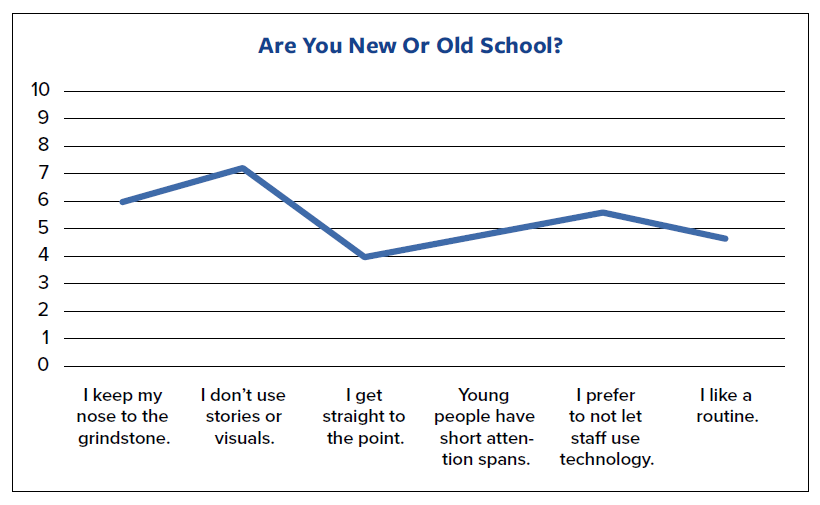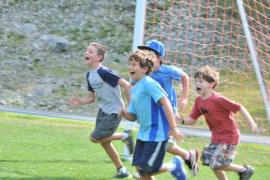Unanswered emails. Requests (demands) for time off. Over-involved parents. What's the matter with young people today? Most likely nothing! We have more in common with this cohort of staff than one might think; their needs are just expressed differently. The way we view the world and the expectations we hold for others are heavily influenced by the population cohort to which we belong. For this and future staff recruiting seasons, we have an opportunity to communicate that we are in touch with the times and yet have a handle on timeless wisdom. We can recruit staff demonstrating that we understand the perspectives of those we hope to hire without compromising important vision, values, and views.
Where We Are Now
In an informal poll at the recent ACA, Southeastern Fall Conference, it was evident that as a camp community we share common beliefs about the expectations we hold for those joining our staff teams. About 43 percent of camps represented agreed or strongly agreed that email and other communication should be answered by a recruit within 24 hours. This could indicate that we are getting used to the fact that college-age students may not regularly check email. Approximately 60 percent of respondents expected staff to stay for the full camp season plus the time required for training. Yet camps often receive requests for extended time off outside of the normal day off to attend a wedding, family reunion/vacation, or other multiday commitment.
It was not a surprise that 96 percent expected staff to show up on the first day of training and not skip out on a contract leaving camp short-staffed. Close to threefourths of camps reported that they were not operating at full capacity for staff at least 5 percent of the time, and some were over 15 percent short-staffed. Of those at the conference, 81 percent were of the mindset that there should be no or minimal use of technology by staff while on duty. This is knowing that some camps utilize mobile devices as a way for staff to communicate official business with each other throughout the day. Finally, about 95 percent preferred that staff advocate for themselves and that parents stay out of the employment process. Yet we know that parents are commonly part of the employment equation.
Old School vs New School
We also invited individuals to explore leadership and communication tendencies by rating themselves on a scale of 1–10 for the following statements (see the accompanying chart). A lower number indicates a shift toward more modern or "new school" ways, while a higher number suggests more traditional or "old school" habits. Not to say that one is better than the other, but to meet staff where they are, it is helpful to see if we tend to be stuck in our ways or if we are keeping up with the times. Think about where you would score on these statements:
- I keep my nose to the grindstone and continue doing my job the best I can; unfortunately, I don't take a lot of time to keep up with all the cultural changes taking place today.
- I don't normally use stories or visuals when I communicate to staff.
- I get straight to the point and don't mess around with the why; I go right to the what.
- One of the biggest challenges I face when it comes to young people is their short attention spans. They just don't pay attention to anything that's too long.
- The world is too full of screens and portable devices, so I prefer to not let staff use technology when they are with me or during camp.
- I like to find a routine that works and stick with it. Each summer I try to challenge staff to make shifts to my style to maintain efficiency within camp operations.
(adapted from Elmore, 2017)

Where Staff Are: Today's Expectations
If we are going to meet staff where they are, we first must recognize and acknowledge their expectations of the ideal workplace. One of the most important elements of the workplace environment is beliefs about communication among those at camp. Young people today expect to be able to communicate with and be heard by all levels of management. After all, they can directly tweet the president; why not have direct and immediate two-way communication with the camp director? Further, today's young staff (18- to 24-year-olds) expect that their ideas, needs, and contributions will be respected and validated. They believe their life experiences have provided them with unique perspectives that are valuable to workplace success.
As part of communication, staff want frequent and honest feedback. They expect positive reinforcement for what they are doing right and, when needed, they want corrective feedback in a caring, coaching fashion. By couching feedback in the framework of personal and professional development, staff will be able to see its validity and accept it for what it is. Because of this need for frequent feedback, mid-season and end-of-season evaluations are insufficient. Providing informal feedback multiple times during the week helps to let staff know their contributions are being noticed and are viewed as important to achieving the camp mission.
Staff expect to be included — they want to feel connected to peers and supervisors, respected for who they are and what they bring to the table, and to know they are contributing to the camp's success. Staff training is traditionally designed to begin the process of being in relationship to others. We recommend that this type of inclusion be intentionally built into pre-camp communications as well as staff gatherings throughout the camp season.
Research shows that young people expect an opportunity to advance in the staff structure — to receive more responsibility and upward positions/titles. They expect supervisors to have their backs and support them in their professional development and in creating networks. When directors are purposeful in helping staff to create and nurture these networks, they are contributing to staff's personal and professional growth.
Cohort Differences
Based on the generational cohort to which one belongs, people see the world differently. They see different opportunities, threats, and response choices, and have distinct cultural lives and expectations. By acknowledging that all worldviews have validity from the perspective of the individual with those views, we begin the process of understanding that meeting the needs of the current generation does not mean giving up our own values.
For example, the elder cohort that works at camp (Baby Boomers as a generalization) experienced landing on the moon and civil rights in their lifetimes. This has influenced people in this cohort to see a life of possibility as well as the notion that struggle can lead to change and everyone deserves equality. The next generation (Gen X) faced cultural events that impacted their view of responsibility and caretaking. The following generation (Millennials) has been influenced by both the threat and promise of what technology can bring. Finally, the most recent cohort (Gen Z) has felt the need to draw into and rely on itself and family, resulting in close child/parent ties.
Cohort Similarities
While we can acknowledge cohort differences, generational cohorts are actually more alike than different. We all want to belong, to be accepted for who we are and how we present ourselves. People share a need to live a life of meaning and to make a difference in the world. All cohorts have drives to experience freedom, autonomy, and independence, while at the same time having a need for connection and relationships. In addition, we all are social beings; we experience a need to work with others — to collaborate, trust, support and be supported, and to contribute as a member of a team. These are all needs that camp can accommodate.
Meet the Perennials
Long-lasting and recurring are words often used to describe perennial flowers because they come back year after year. A similar definition can be used when talking about people who transcend the concept of generations. Gina Pell is given credit for coining this term in this context and states that perennials are "ever-blooming, curious people of ALL ages who know what's happening in the world, stay current with technology, and have friends of all ages. I'm talking about a mindset. Not a flat, one-dimensional timeline that runs from birth punctuated by generational barriers designed to categorize and divide us" (Pell, 2016). Oprah, Lady Gaga, Tony Bennett, Justin Trudeau, and Malala Yousafzai, for example, come to mind as people who belong to an ageless generation. Age is not an identifying factor for perennials and shouldn't be for us as camp professionals if we are truly going to take steps in the direction of meeting staff where they are.
Remix: Timeless and Timely
Change is never easy. There is always work involved when switching from an old method to a new approach. Trying something new can seem risky because there are no guarantees on the rate of success. Some people in an organization may be reluctant to change and inhibit evolution. However, change requires recognition that what has been done before may not be producing the same results as in the past. (Elmore, 2017)
As Greek philosopher Heraclitus reminds us, "change is the only constant in life." As much as we would like staff to act in ways that match ours, it is nearly impossible to make them change. The only person we can control with regard to change is ourselves. We recognize that what keeps us from moving forward is often the fear of losing our identity in the process. So is it possible to meet staff where they are without losing our vision, values, and views? We believe the answer to that is yes.
One way to think of this idea of holding onto the core of who we are as a camp yet taking a step to meet staff is to compare it to the remix of a song. Lindsey Pollak describes a remix as "a song that has been changed from its original state by a new artist who adds, subtracts, or alters the original in some way to create something both recognizable and entirely new" (2019). Remix songs are often more popular than the original versions. The older version is still familiar and provides roots for the song, while the newer edition gives it wings as it is modernized and brought up to date. This blending of the old and new appeals across the ages.
Queen's "Bohemian Rhapsody" is a classic example of combining old music styles with current sounds. Tim Elmore states, "the mixture of modern sounds (which is almost always attractive to a young generation) with more traditional sounds keeps listeners feeling like they're staying attached to their heritage. I have found students have an interesting affinity to both cutting edge ideas and traditional connections to the past" (Elmore, 2019).
The musical Hamilton offers another example of the intersection of old and new for it is "yesterday's story told in today's style" (Elmore, 2017). Even Patagonia advertises their Blackhole bags in this fashion as they suggest that they are the same great bags but are now made smarter by using 100-percent recycled materials. Having the same look speaks to the brand that loyal customers have come to trust, while reusing factory scraps and plastic bottles simultaneously appeals to today's environmentally conscientious consumer.
It is possible to be both timely and timeless at the same time as we set out to meet staff where they are. It does not mean that camp vision, values, and views must change in the process. We can be timeless with our vision, mission, and values and timely with the methods used to portray these messages. The reason for a camp's existence most likely hasn't changed over time; however, the camp program may look differently than it did five, 10, or 15 years ago. Gaga ball and computer coding now deliver the camp mission in a way that reaches today's participants. The content created about a camp remains timeless; the way in which it is communicated is timely. Brochures and phone calls have been replaced with landing pages, tweets, and posts on various social media. Timeless invokes a memory while timely leads to discovery (Pollak, 2019).
Addressing the Needs of Today's Staff
Today's staff want to have a purpose and make a difference. At camp this translates into changing the lives of campers and contributing to the camp mission. Work-life balance is a very important need for staff — they see value in both. Taking care of oneself and managing familial and friend relationships are equally as important as work. This is often seen in requests for time off during the summer. Being flexible with hiring arrangements can be responsive to this need. As employers, camps can teach and reinforce the learning of 21st-century skills — communication, collaboration, critical thinking, and creativity. This responds to the desire for personal and professional development.
Camp settings are perfect to help others develop and gain mastery in a variety of interpersonal and technical skills. Employers can take on the role of helping to "grow" staff in a similar way that they grow campers. In addition to these steps, we suggest that messages be short, visual, and interactive to situate the communication in a way that is most acceptable to today's staff. Simply adding a question to the staff application (mobile, if possible) to find out the preferred method of communication can alleviate the frustration of unanswered messages.
Three Questions to Ponder
One of the most dangerous phrases in the English language is "we've always done it this way." With that said, we would like to leave you with a few questions to think about as you examine your camp's recruiting and hiring practices to see if you are meeting staff where they are and not where you wish they would be:
- What should we stop doing because it no longer works?
- What should we remix or do differently so that it meets staff today?
- What should we do in entirely new ways to succeed?
| For More Information For other ideas on how to meet staff in ways that match with today, ideas gathered at two think tank sessions at the 2019 ACA, Southeastern Fall Conference can be found on the Project Real Job webpage. Other resources about recruitment, hiring, and retention are also on that page. |
References
- Elmore, T. (2017) Marching off the map: Inspire students to navigate a whole new world. Atlanta, GA: Poet Gardener.
- Elmore, T. (2019, April 10). Three leadership secrets from bohemian rhapsody. Growing Leaders. Retrieved from: growingleaders.com/blog/three-leadershipsecrets-from-bohemian-rhapsody/
- Pell, G. (2016, October). Meet the perennials. The What. Retrieved from thewhatlist.com/meet-the-perennials
- Pollak, L. (2019) The remix: How to lead and succeed in the multigenerational workplace. New York, NY: HarperCollins.
Deb Jordan, ReD, is a professor at East Carolina University and speaks and writes about a variety of topics of interest to camps and other entities. She also serves as the standards co-chair for the ACA Southeast Local Council of Leaders, contributes to Camping Magazine, presents webinars, and is co-chair of the ACA Project Real Job Committee.
Kim Aycock, MST, has 30+ years of experience developing young people with skills robots are unable to do. While blending the talent of a master teacher with the knowledge of a seasoned camp expert, Kim ignites learning for varying levels of campers and staff worldwide. She speaks professionally at conferences, presents webinars, contributes regularly to Camping Magazine and ACA blogs, and serves as co-chair of ACA's Project Real Job Committee. More information can be found at kimaycock.com.
Photo courtesy of Overland Summers, Williamstown, Massachusetts.


